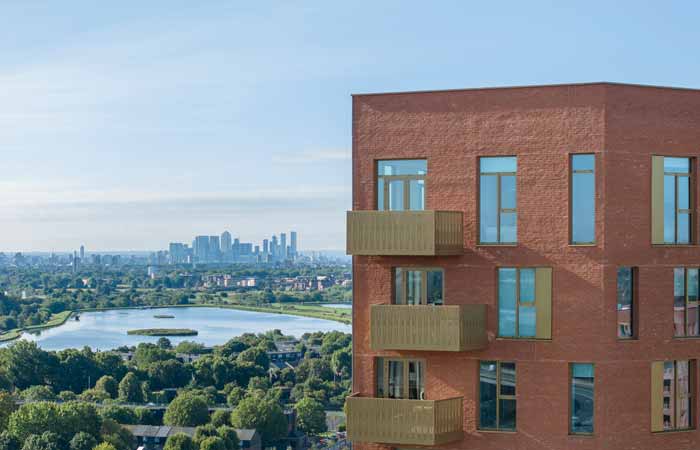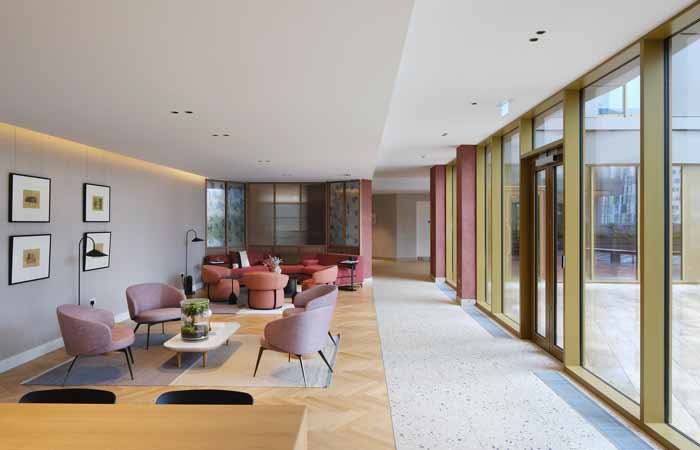Commercial and Residential Synergy at One Ashley Road: Alison Brooks Architects completes flagship for Tottenham Hale
One Ashley Road is Alison Brooks Architects’ landmark project for the client, Related Argent, forming the gateway to the Tottenham Hale redevelopment, Heart of Hale. The scheme is situated near the Walthamstow Wetlands and Lea Valley waterways, and features three levels of retail and incubator office spaces as part of a larger vision for transforming a post-industrial, traffic-dominated transport hub into a characterful, diverse, and walkable neighbourhood. The development includes two residential towers framing two sides of a courtyard block and houses 183 residential units, complemented by roof gardens and a new public realm.

Alison Brooks Architects’ design responds to the characteristics of the historic, existing, and emerging context. It defines the northern edge of a new transport interchange and acts as a threshold to a dynamic new neighbourhood. The scheme offers a new tree-filled civic square at the ‘prow’ of the site, as well as a characterful new pedestrian passage that leads into the Berol Factory Courtyard.

One Ashley Road acts as the ‘front door’ to the Heart of Hale masterplan. Its animated silhouette and colonnaded base, situated opposite the Tottenham Hale transport hub, creates a memorable new identity rooted in place. The scheme references the area’s industrial heritage, particularly the adjacent Berol House which was once part of the Eagle Pencil Company Factory, with a ‘carved’ and animated perimeter block. This is expressed through a distinctive, faceted form and a more pronounced verticality. With a rich orange brick outer skin and a shimmering metal inner skin, the design is inspired by the graphic colours and hexagonal forms of the iconic Berol Eagle Pencil. These have been translated formally as abstract surface patterns within the architecture of the building.

The scheme’s stepped massing creates a secluded residents’ podium garden and co-working space at third-floor level and a south-facing communal roof garden at seventh-floor level. This prominent space overlooks the new square, and the mid-rise scale softens the transition between the tall elements and the public realm. In contrast to its smooth terracotta exterior, One Ashley Road’s internal elevations feature faceted metal cassette panels which reflect light into the block interior, so that its heart becomes a shimmering veil of light. Overcoming a significant underground constraint with both ingenuity and sculptural intent, One Ashley Road’s design responds to the presence of two Victoria line tunnels running through the plot.

By strategically locating the two towers and their respective piling on either side of the tunnels, the project team navigated loading, acoustic, and vibration requirements from the London Underground infrastructure. This innovative approach to the site’s unique conditions resulted in a stepped-base massing block, which recesses to the north to offer communal green terraces. These outdoor spaces provide residents with access to air, light, and panoramic views, seamlessly integrating the built environment with the natural landscape.

The gardens and hexagonal terrace weave green space throughout the project, creating communal destinations for residents to get together, socialise, and relax in a variety of quiet, secluded locations.

One Ashley Road achieves BREEAM Very Good as the development addresses both the Tottenham Green Grid (Policy AAP9; TAAP) and the Council’s Open Spaces Strategy. The development’s operational carbon savings exceed the Greater London Authority’s targets by an impressive 48%.

This high level of environmental performance is achieved through the building’s connection to a District Energy Network (DEN), which provides the base heat load for the entire development and reduces reliance on traditional heating sources. Furthermore, the project is equipped with solar photovoltaic panels, smart metering, and energy management software, enabling efficient monitoring and optimization of energy usage throughout the building’s lifecycle.

Embracing a “Be Lean, Clean and Green” approach, the complex incorporates a range of passive design features and a ‘fabric first’ strategy to reduce its energy demand. Detailed design emphasising a highly insulated building envelope aims to achieve resource efficiency and lower operational costs.




